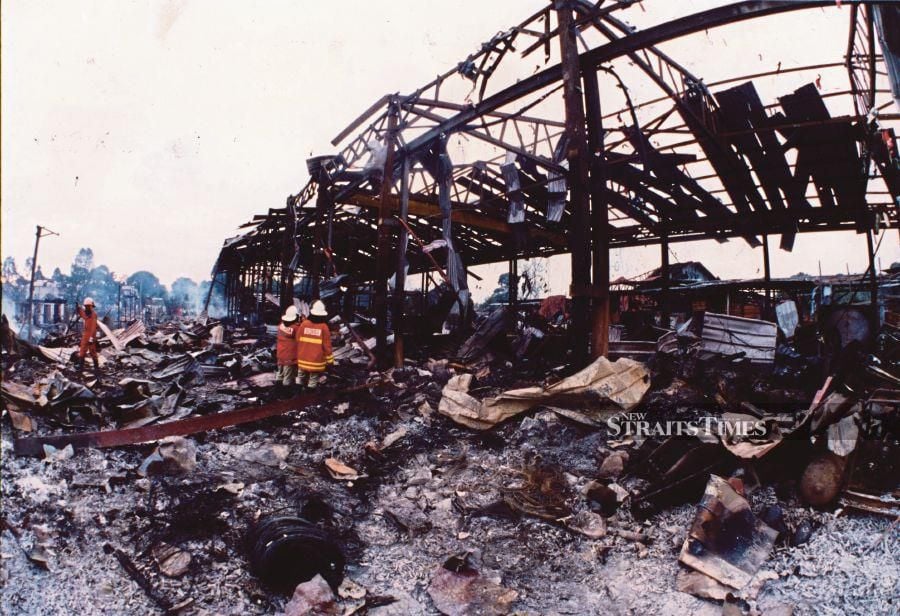Bright Sparkler Disaster – What Happened, What We Can Learn
The Bright Sparkler explosion stands as one of Malaysia’s worst industrial disasters, causing massive destruction, multiple fatalities, and significant regulatory changes in the handling of hazardous materials.
On May 7, 1991, a fire and subsequent explosion at the Bright Sparkler Sdn. Bhd. fireworks factory in Sungai Buloh, Selangor, resulted in a devastating accident that shook the nation. The explosion killed 26 people and injured over 100 others, while sending shockwaves across the surrounding areas.
The disaster highlighted critical lapses in industrial safety regulations and led to increased government oversight in the handling of explosive materials.
The Events Leading to the Bright Sparkler Disaster
On the morning of May 7, 1991, routine operations were being carried out at the Bright Sparkler fireworks factory, where firecrackers and pyrotechnic materials were being processed. At approximately 3:45 PM, a small fire broke out in one of the storage areas, quickly spreading due to the highly flammable nature of the materials stored within the facility.
Factory workers, unaware of the magnitude of the danger, attempted to extinguish the flames but were unable to contain the fire.

Within minutes, a series of powerful explosions occurred, sending debris and burning chemicals flying across the factory compound and into the nearby Sungai Buloh area.
The force of the explosion shattered windows and damaged buildings up to seven kilometers away, creating a mushroom cloud of smoke and flames visible from great distances. Due to the sheer intensity of the explosion, the blast ignited nearby factories and residences, causing further chaos and destruction.
Immediate Impact and Response
The explosion led to widespread panic and confusion, with emergency response teams struggling to reach the affected site due to fires and debris blocking access routes. Firefighters, paramedics, and law enforcement officers were deployed to contain the disaster and assist survivors.
Many factory workers and bystanders suffered severe burns, blunt force trauma, and shrapnel injuries, while others were trapped under rubble.
Emergency responders faced significant challenges in extinguishing the fire due to the presence of volatile chemicals and gunpowder, which continued to reignite. The Royal Malaysian Police (PDRM) and the Fire and Rescue Department of Malaysia (BOMBA) worked tirelessly to secure the area and prevent further explosions.
The surrounding neighborhoods were also evacuated to prevent additional casualties from toxic smoke and secondary explosions.
Causes of the Bright Sparkler Explosion
Investigations into the Bright Sparkler explosion revealed multiple safety violations and regulatory oversights that contributed to the scale of the disaster. Highly flammable pyrotechnic chemicals were improperly stored in close proximity, which allowed the fire to spread rapidly.
The factory lacked adequate sprinkler systems and emergency fire extinguishers, making it nearly impossible to control the blaze. Employees were not adequately trained in fire safety and emergency response, which led to panic and ineffective evacuation efforts.
Furthermore, the factory violated several industrial safety guidelines, including improper handling and disposal of hazardous chemicals, exacerbating the severity of the disaster.
Long-Term Consequences
The explosion at Bright Sparkler had far-reaching consequences, prompting sweeping changes in Malaysia’s industrial safety policies. Following the disaster, the Malaysian government implemented stricter regulations for the storage, transportation, and handling of explosive materials.
The incident also served as a wake-up call for other industries dealing with hazardous chemicals, leading to enhanced safety training and enforcement measures.
Health and Environmental Impact
Many survivors of the explosion suffered from long-term health complications, including severe burns, respiratory issues, and psychological trauma. The surrounding environment was also heavily affected, with chemical contamination in the air and soil, leading to long-term ecological concerns.
Changes in Safety Regulations
As a direct result of the disaster, the Occupational Safety and Health Act 1994 (OSHA 1994) was reinforced to ensure better compliance among industrial operators. Fire safety inspections became more rigorous, and factories dealing with flammable materials were required to implement emergency response protocols and conduct regular fire drills.
Lessons Learned from Bright Sparkler
The Bright Sparkler explosion underscores the necessity for rigorous enforcement of fire safety regulations. Companies handling hazardous materials must ensure that all substances are stored, handled, and disposed of following strict safety standards. Compliance with fire prevention measures, such as having well-equipped sprinkler systems, fire extinguishers, and adequate emergency exits, is essential to mitigate risks.
Additionally, proper training for employees working in high-risk environments is crucial. Workers must receive comprehensive training on fire safety and emergency response protocols to ensure they can react effectively in the event of a fire or explosion. Employers must implement ongoing training programs to keep workers informed about the latest safety procedures and emergency drills.
The need for proactive government intervention and regular safety audits is also evident. Authorities must conduct frequent inspections of industries handling volatile materials to ensure compliance with safety guidelines. Strict penalties should be imposed on companies that fail to adhere to industrial safety regulations, as non-compliance can have catastrophic consequences.
Moreover, crisis management and emergency preparedness must be prioritized to ensure quick responses to industrial accidents. Companies must establish well-defined emergency action plans, including designated assembly points, clearly marked evacuation routes, and rapid coordination with emergency response teams.
Public awareness about industrial safety is another critical takeaway from this tragedy. Communities near high-risk factories should be educated on emergency procedures and evacuation plans to minimize casualties in case of an accident. Establishing communication channels between factories, local authorities, and the public will enhance preparedness and reduce panic during emergencies.
Conclusion
The Bright Sparkler explosion remains one of Malaysia’s most tragic industrial disasters, underscoring the critical need for strict safety regulations and compliance in high-risk industries. While regulatory changes have since been implemented to prevent similar incidents, the tragedy serves as a reminder that safety should always be the top priority in any industrial operation.
The victims of the disaster must never be forgotten, and the lessons learned should continue to guide workplace safety policies to ensure a safer future for all.
References
Bright Sparklers fire and explosions: The lessons learned, ResearchGate
